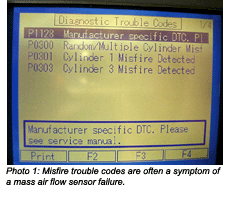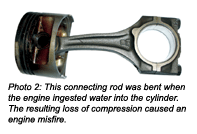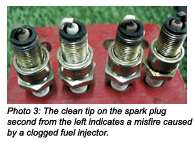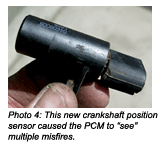Without question, the 1996 and newer OBD II systems have greatly simplified the diagnostic process. Veteran mechanics well remember the technical loopholes that riddled the old proprietary OBD I systems. All too often, the complex diagnostic charts supplied by the auto manufacturers were time-consuming, erroneous and often concluded with the infamous “replace with component of known value.” As a result, the diagnostic process became as intuitive as it was technical, with technicians becoming more reliant upon their digital lab scopes than upon their scan tools to make a critical diagnosis.
Symptom Vs. Disease
Nevertheless, as comprehensive as these systems have become, a trouble code produced by a modern OBD II system doesn’t always pin-point the root cause of a failure (see Photo 1). Many technicians have found, to their dismay, that a P0304 DTC was a symptom of a leaking heater hose on a Ford Expedition instead of a coil or spark plug problem.
 Similarly, many technicians have chased intermittent misfire codes on an engine only to find that the misfire was caused by a cylinder head gasket leaking coolant onto a set of brand-new spark plugs! And then we have the really off-the-wall misfire failures like those caused by a bent connecting rod (see Photo 2).
Similarly, many technicians have chased intermittent misfire codes on an engine only to find that the misfire was caused by a cylinder head gasket leaking coolant onto a set of brand-new spark plugs! And then we have the really off-the-wall misfire failures like those caused by a bent connecting rod (see Photo 2).
With that said, it’s important to understand that OBD II systems don’t interpret data in a generic, mechanistic way. A PCM “sees” only what it is programmed to “see” and, while the basic electrical inputs might be essentially the same, the proprietary diagnostic strategies programmed into individual PCMs may interpret those electrical inputs in different ways. This rather problematic issue requires a skilled tech to be very knowledgeable about a vehicle’s operating system in order to understand which factors are involved in setting the P0300 DTC. And that’s where our understanding of the misfire monitor should begin.
 The Misfire Monitor
The Misfire Monitor
Due to running changes in misfire detection strategy implemented over the past 10 years, understanding the specifics of misfire monitor operation has become more complicated than ever. In essence, we can say that a monitor is a test built into the PCM’s self-diagnostic strategy that is run when a specific set of operating conditions known as enabling criteria are met. We can also say that a misfire monitor is a “continuous” monitor that runs as long as the enabling criteria are met.
A “Type A” misfire will illuminate the Malfunction Indicator Light (MIL) if it detects a misfire that might cause the catalytic converter temperature to exceed 1,500-1,800° F. A “Type B” misfire will illuminate the MIL if a misfire occurs that might increase exhaust emissions, but not damage the catalytic converter. To illuminate the MIL, the Type A misfire requires only one “trip” meeting the enabling criteria while the Type B misfire requires two separate “trips” meeting the enabling criteria.
In order to fire correctly, a cylinder needs at least 80% of normal compression, a correct air/fuel mixture ratio, no restrictions in the intake or exhaust systems, and a fully functioning ignition system. When one or more of these conditions aren’t met, a misfire will usually occur.
To understand how the PCM detects a misfire, let’s begin by saying that a properly firing cylinder briefly accelerates the crankshaft. In general, the PCM detects a misfire condition by measuring the time between crankshaft accelerations. If a cylinder misfires, the PCM detects deceleration rather than acceleration in the crankshaft. It is this deceleration (or lack of acceleration) that prompts the PCM to set a P0300-series DTC.
Originally, many vehicles were programmed to “see” a cylinder fire 500 times in 1,000 engine revolutions per minute. Later-model vehicles might narrow the count to 100 cylinder firings in 200 rpm. In addition, some vehicle manufacturers programmed their PCMs to shut off the fuel injector on a misfiring cylinder in order to prevent damage to the catalytic converter. Additionally, some misfire monitors were too sensitive and illuminated the MIL when, in fact, no misfires were present. A good example is auto manufacturers originally not estimating the effects that driving a vehicle on a washboard surface would have on the misfire monitor. In such cases, misfire codes were stored for no apparent reason. In response, engineers began modifying their misfire monitors during the late 1990s to accommodate uncommon driving conditions. In some cases, the PCM is programmed to deactivate the misfire monitor if it detects a washboard road condition.
In any case, the misfire monitor is designed to count the number of misfires occurring in either 200 or 1,000 engine revolution segments. When the PCM counts a critical number of misfires within the specified number of cylinder firing events, it will store either a Type A misfire DTC and turn on the MIL, or it may store a Type B misfire in pending codes and wait to turn on the MIL if the misfire returns during a second-trip driving condition.
Case Studies
Understanding the misfire code as a symptom is more aptly illustrated by thumbing through a number of new and old case studies. To begin with, any practical experience with misfire conditions will reveal the vastly different methods in which a vehicle’s PCM detects misfires and stores them as P0300 trouble codes. During the early days of OBD II, for example, I was diagnosing two Subarus with misfire codes. Both were mechanically identical with the exception that one was a 1996 and the other a 1997 model. The ’96 model would immediately record a Type A misfire occurring intermittently through a perforated spark plug boot. During an effort to diagnose a very random P0304 cylinder #4 misfire on the ’97, I discovered that grounding one spark plug wire would not store a misfire in the PCM’s diagnostic memory, no matter how many laps around the shop I did with the vehicle.
If you’re working with more than one scan tool, you’ll also discover that scan tools interpret misfire data differently. A P0300 on one scan tool might show up as a P0300, P0301, P0302, P0305, etc., on another. Consequently, the more misfires you diagnose, the more you’ll see that there’s more to misfire diagnosis than simply reading the displayed trouble code.
Firing Order Misfires
Most recently, a 2001 Chevrolet Tahoe came in with a no-power and no transmission up-shift complaint. A preliminary scan revealed that the left-bank cylinders (1, 3, 5 and 7) were misfiring. A road test confirmed that the engine lacked power and that the transmission (for that very reason) remained in an intermediate gear. My first impression was that a catalytic converter had clogged, but before spending the money on an expensive converter, I had to prove my case.
The ignition configuration on this particular engine uses one coil per cylinder and a single spark plug wire to connect the coil to the spark plug so, clearly, it would be highly unlikely for each of the left-bank cylinders to experience a primary or secondary ignition failure. On the other hand, a conventional vacuum gauge test indicated that the intake manifold vacuum was nearly normal at a 2,500 rpm steady-throttle condition. Since the exhaust system contained an individual converter for each cylinder bank, I installed a pressure tap in place of the upstream oxygen sensor on the left bank. The left bank exhaust pressure indicated 6 psi at idle, which meant that the converter had melted and clogged the outlet.
In this case, the misfire codes were stored because an exhaust restriction disrupted the combustion process. Of course, this is a chicken-or-egg situation, because one or more misfiring sparks on the left bank might have overheated the converter. Just to be safe, I replaced all the spark plugs and wires because, even at 89,000 miles of service, I couldn’t prove that a misfire hadn’t originally caused the catalyst failure.
Another case study previously mentioned in this column emphasized the use of firing order to diagnose an intermittent misfire. Specifically, the case was a 1997 Dodge Intrepid 3.5L engine with a slightly rough idle and poor power and fuel economy. After carefully questioning the owner, I found that the problem had appeared shortly after a timing belt had been replaced. Obviously, the only question left was which of the overhead camshafts was out of time. A scan tool provided the evidence by indicating that the majority of misfires were coming from the right-hand cylinder bank. Removing the timing cover confirmed that, indeed, the previous technician hadn’t correctly aligned the camshaft timing marks, which, in turn, caused a loss of compression on the right-bank cylinders.
Freeze-Frame Misfire Diagnostics
Intermittently occurring misfire codes seldom leave a clear diagnostic path. A good illustration is a 1998 Dodge Intrepid 3.5L that kept coming in with an intermittent MIL and misfire codes that appeared to alternate between each cylinder bank. Needless to say, the misfire could never be duplicated but, thanks to recording the freeze-frame data each time the vehicle came in with a misfire code, I discovered that the majority of the misfires were coming from the end cylinders on each bank. The freeze-frame data indicated that the misfires were disappearing as the engine reached operating temperature. This led me to believe that the misfires were being caused by an intermittent intake manifold vacuum leak. An inspection of a new set of upper plenum gaskets revealed that, indeed, these gaskets had a weak area near the extreme end of the gasket. Removing the upper plenum proved my theory to be true.
Air/Fuel Misfire Diagnostics
As mentioned above, any major variance from a stoichiometric air/fuel ratio can cause a misfire code to be stored. A dirty, miscalibrated or electrically defective mass air flow (MAF) sensor, for example, can cause a condition that is recognized by the PCM as a cylinder misfire. Two examples of this condition come to mind: a 2001 Hyundai with an intermittent poor cold driveability complaint and a 2000 Nissan Sentra that would idle, but simply wouldn’t develop enough power to move out of its tracks.
The Hyundai misfire trouble codes were complicated by the owner neglecting the scheduled spark plug replacement intervals. But, even with the spark plugs replaced, the engine would occasionally refuse to run when cold and would store random cylinder misfire codes. The Nissan Sentra followed the same pattern, but the spark plugs had been replaced.
The Hyundai diagnosis was simplified by looking up a technical service bulletin that specified the grams per second air flow at various no-load engine speeds. Using that data, it was obvious that a miscalibration in the Hyundai’s MAF was causing a cylinder misfire by causing a lean misfire condition. The Nissan’s MAF, on the other hand, demonstrated a very erratic voltage signal on a lab scope display, which explained why it would occasionally run in a normal fashion.
 Similarly, a clogged fuel injector causing a misfire can be very difficult to detect because the engine has spark and some degree of fuel. A close inspection, however might reveal a difference in spark plug coloration. In Photo 3, it’s easy to see that the second spark plug from the left represents the cylinder starving for fuel.
Similarly, a clogged fuel injector causing a misfire can be very difficult to detect because the engine has spark and some degree of fuel. A close inspection, however might reveal a difference in spark plug coloration. In Photo 3, it’s easy to see that the second spark plug from the left represents the cylinder starving for fuel.
In contrast, I retrieved random misfire codes from a 2001 Chevy truck with a hot-starting complaint. In line with the title of this article, the misfire codes contained in the PCM were a symptom of a common failure on these models of General Motors trucks, which is a leaking fuel pressure regulator. By temporarily causing the cylinders to run rich, a set of basically irrelevant misfire codes were stored in the diagnostic memory.
Last, it’s important to remember that EGR issues can cause a misfire on some vehicles. Clearly, a cylinder won’t fire if it’s filled with inert exhaust gas. Individual ports on some ported EGR systems can clog, which can cause a misfire by allowing an excess of EGR to flow to the remaining cylinders. EGR gas that is evenly distributed through a single port clearly shouldn’t cause a misfire condition. But even that situation might be subject to individual design issues and PCM programming issues on various engine configurations.
Mechanical Misfire Diagnostics
Most recently, I diagnosed a cranking, no-start complaint on a 2002 Dodge Intrepid as a bad crankshaft position (CKP) sensor. Since the diagnosis was a sublet from another shop, the shop installed a new CKP sensor. With the new CKP installed, I used the CKP relearn procedure contained in my scan tool to finish the job.
A few days later, the Dodge returned with a MIL-on complaint. Misfire codes were stored for all six cylinders and the freeze-frame data showed that the misfire was occurring after the engine had warmed up and was running at highway speeds. No MIL-on condition had been noted before the cranking, no-start complaint. After clearing the misfire codes, I took the Dodge for a road test. Fortunately, the scan tool I was using displays cylinder misfires. I could see that, after the engine had warmed up and was operating under a load above 2,500 rpm, the scan tool started counting misfires.
Here again, the engine was equipped with coil-on-plug (COP) ignition, so it was unlikely that the misfires were caused by faulty secondary ignition. Fuel trims were normal, which eliminated fuel-related issues. In fact, the engine ran extremely well and didn’t exhibit any cylinder miss whatsoever, even as the scan tool was recording cylinder misfires.
 During the inevitable research involved in a case like this, I recalled a Nissan Pathfinder with a loose harmonic balancer that caused a similar false misfire coding problem. In addition, I discovered anecdotal evidence that rare factors like serpentine belts with an over-lapped splice and the occasional rough defective timing belt would cause timing deflections that might be mistaken by the PCM as an engine misfire.
During the inevitable research involved in a case like this, I recalled a Nissan Pathfinder with a loose harmonic balancer that caused a similar false misfire coding problem. In addition, I discovered anecdotal evidence that rare factors like serpentine belts with an over-lapped splice and the occasional rough defective timing belt would cause timing deflections that might be mistaken by the PCM as an engine misfire.
But the only part that had been changed on the engine prior to the misfire codes was the CKP sensor. Armed with nothing but this logic, I recommended that the shop replace the aftermarket sensor with an OE sensor. The CKP replacement eliminated the misfire codes and the MIL-on condition. For whatever reason, the aftermarket CKP was indicating a misfire condition to the PCM when that certainly was not the case (see Photo 4).
Whenever diagnosing a misfire condition, it’s important to consider all of the factors involved including those that I have covered in the above case studies. When diagnosing any misfire condition, looking up the enabling criteria specific to the application will always prove to be a big help. In the meantime, remember: as new vehicles are built, new problems will follow!








